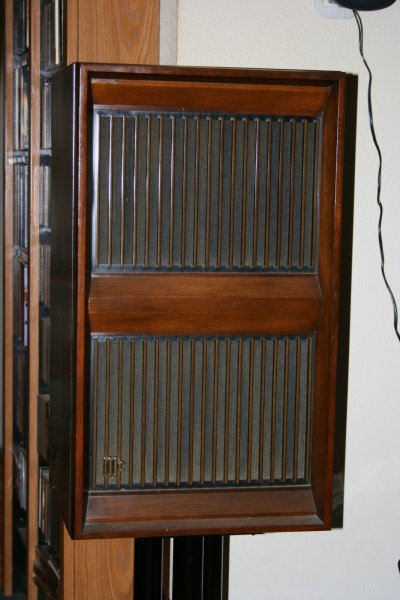NW-Bound
Give me a museum and I'll fill it. (Picasso) Give me a forum ...
- Joined
- Jul 3, 2008
- Messages
- 35,712
It's time to let y'all know about my effort with reviving the 2nd pair of vintage speakers: the Sansui SP-3500. Here's an image linked from the Web. I wish mine looked that good. The grill work was hand-carved, and called Kumiko. Purists poo-pooh'ed this and say it causes diffraction. I like the style though. On audiokarma, a poster said that he worked at JBL at the time frame these Sansuis were produced (1968-1972), and knew that JBL designed these speakers for Sansui. Note that some JBLs used similar acoustic lenses like on these Sansuis.

These speakers are of about the same vintage as my already shown Pioneer CS-88, but of a bit higher class. It's a 4-way bass reflex, with a 14" woofer, two 4" paper-cone low-midranges, a high-midrange horn with an acoustic lens, and two horn tweeters.
It's the tweeters of one speaker that were blown-out. I took off the high-frequency assembly to change them. See photo below.

When I looked for replacements on eBay, there was not any offered (there are now). So, I had to get an earlier version of these horn tweeters. See photo below. The original tweeters were die-cast and looked higher-quality than the earlier versions.

I frequency-swept the replacement horns, and found them to be OK. They dropped 10dB between 15KHz and 20KHz, but I cannot hear above 13KHz anyway, and seriously doubt if I could hear that high even when younger. The dispersion did not look too bad either, and got to +-60-deg off-axis while the newer Vifa tweeters I put in the CS-88 fell off drastically at that angle.
And hey, my hearing is still good enough to know that these speakers were lacking in the high end of the range.

Here's the measured response of the replacement tweeters along with the rest of the speaker (the lower 3-way part of the 4-way). I was pleased to see that these tweeters going to blend in nicely, if the crossover still worked. And of course it did, else I would not be able to get the 3 out of 4 ways to work that nicely at the lower frequencies.


These speakers are of about the same vintage as my already shown Pioneer CS-88, but of a bit higher class. It's a 4-way bass reflex, with a 14" woofer, two 4" paper-cone low-midranges, a high-midrange horn with an acoustic lens, and two horn tweeters.
It's the tweeters of one speaker that were blown-out. I took off the high-frequency assembly to change them. See photo below.

When I looked for replacements on eBay, there was not any offered (there are now). So, I had to get an earlier version of these horn tweeters. See photo below. The original tweeters were die-cast and looked higher-quality than the earlier versions.

I frequency-swept the replacement horns, and found them to be OK. They dropped 10dB between 15KHz and 20KHz, but I cannot hear above 13KHz anyway, and seriously doubt if I could hear that high even when younger. The dispersion did not look too bad either, and got to +-60-deg off-axis while the newer Vifa tweeters I put in the CS-88 fell off drastically at that angle.
And hey, my hearing is still good enough to know that these speakers were lacking in the high end of the range.

Here's the measured response of the replacement tweeters along with the rest of the speaker (the lower 3-way part of the 4-way). I was pleased to see that these tweeters going to blend in nicely, if the crossover still worked. And of course it did, else I would not be able to get the 3 out of 4 ways to work that nicely at the lower frequencies.

Last edited:





 .
.